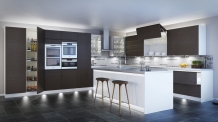Light the good light
 17
17Jul '14
Lighting is an increasingly important aspect of designing the perfect kitchen or bathroom. Advance planning and consulting a specialist can make all the difference to the finished project.
The leading national Kitchen Bathroom Bedroom Specialists Association, the KBSA has amongst its members two of the market leaders in the lighting industry. Gary Baxter, Managing Director of Sycamore Lighting, and Michael Linsky, MD of Sensio UK Ltd, give their top tips for getting your lighting right in the kitchen and bathroom.
Michael Linsky says:
Gary Baxter says:
- All aspects of lighting should be considered during the initial stages of a room’s re-design. When left as an afterthought, this can limit the possibilities available and lessen the impact that lighting can have on a design scheme.
- Kitchens are considered by many to be the ‘hub of the home’; no longer just a place where we cook and clean, they’re also a space in which to socialise and entertain. For this reason it’s important to incorporate a mixture of task lighting and accent lighting into the design scheme. LED solutions are available for the kitchen which combine both and allow users to switch from task to mood lighting at the touch of a button.
- Lighting solutions which feature a Lithium-ion rechargeable battery provide a simple lighting solution for inside kitchen cabinets, providing LED lighting that offers style and function, but can also be installed by anyone. These fittings then only need to be charged two to three times a year via USB adapter.
- It’s important to match the correct lighting temperature to the style of the room. LED lighting is available in ‘cool white’ and ‘warm white’ temperatures. ‘Cool white’ is perfect for contemporary style rooms and will complement glossy finishes and ‘warm white’ LEDs, as the name would suggest, emit a warmer glow, emphasizing the wood grains in a traditionally styled kitchen.
- Something else to think about when selecting lighting for the home is the impact it has on the environment. We’re all undoubtedly becoming more eco-savvy, but with energy companies hiking up their prices in the autumn, selecting energy-efficient products has become even more of a priority for consumers. LED lighting has a low power consumption which means it uses less energy, in turn, lowering household bills whilst also helping the environment.
As LED Technology in the kitchen and bathroom markets continues to evolve, the government has decided that certain controls and criteria need to be met to stop the fanciful claims of more and more lighting distributors. As a consequence of this Sycamore Lighting decided that the only way to make sure that the criteria could be met was to create a laboratory to ensure that all the legal requirements can be attained. For example, Ra (colour rendition) must be a minimum of 80, and all products should comply with the ERP (energy related products) directive, which has become applicable from September 2013.
As lighting evolves it is important that consumers are kept up to date with new developments, such as the introduction of Natural White LED’s. This technology removes the complication of which colour rendition is required for both contemporary and traditional kitchens, as Natural White suits both types of design.
When designing a lighting scheme it is important to consider the following;
More information from:
www.kbsa.org.uk
www.sycamorelightingltd.co.uk
www.sensio.co.uk
- Decide what area is going to be used to carry out tasks and ensure that the location of the lighting will enhance those areas. In a bathroom, illuminated mirrors and over cabinet lighting are considerations, whilst in a kitchen, under-cabinet lighting is always the best option for food preparation etc.
- Now that there are a myriad of options for task lighting, aesthetics also have to be considered. In the past a linear fluorescent light behind a pelmet was deemed the norm. Technical advancements in both light sources and the actual product design allow the client and designer more choices than ever before to make their decisions.
- Flexible LED strip lighting can be installed below the worktops to shine on the base units, as well as under the units to give a floating kitchen effect.
- Colour rendition also has to be a prime consideration, choosing the wrong colour light, or mixing different colours on the same kitchen or bathroom can make an expensive project look poor, and conversely good lighting can make a budget project look spectacular.
- Lighting controls using Smartphone or android technology is now more prominent, and utilised properly can allow scenes to be controlled and set to each client’s individual tastes. For example, in a kitchen various mood settings can be operated to allow for various scenarios on any given installation. These systems can integrate ceiling lighting, furniture lights, and also AV systems.
Picture from Sensio UK Ltd
Telephone: 01384 878777 Fax: 01384 872104 Email: info@ddpr.biz
Enquiries: Downing Dunmore PR
